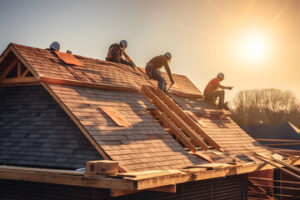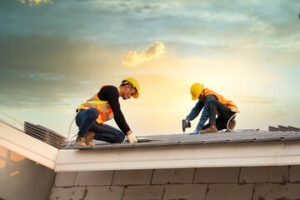Your roof is a sturdy shield protecting your home from the elements. Roofing is the process of choosing and installing a roof, as well as maintaining and repairing it.
It can involve a variety of materials, shapes and styles to suit different climates, architectural tastes and building types. From the gently sloping shingles of cottages to the curved lines of European cathedrals, there are 64 practical roofing options. Click the Roofing Columbus GA to learn more.

When it comes to roofing, there is a wide range of materials to choose from. Depending on how much you are willing to spend and how long you want your roof to last, you can pick from a variety of natural products like thatch or more durable and expensive options such as slate or clay tiles.
Roofing materials are placed on top of a secondary water-resistant material called underlayment. It’s important to use a waterproof underlayment because it prevents leaks from occurring in the areas where the roof meets up with other surfaces such as walls and chimneys.
There are several types of underlayments including asphalt shingles, rubber membrane, wood shingle underlayment, and slate underlayment. Each has its own advantages and disadvantages. Asphalt shingles are typically the most affordable and provide good durability. However, they are not as attractive and may not perform well in cold weather or in areas with high winds. Wood shingle underlayment is an attractive and durable option that provides good insulation. It also resists rot and insect infestation. However, it can be very heavy and may require more frequent maintenance than other underlayment options.
Slate roofing is often used on historical buildings and elegant homes. It has a very distinctive look that is coveted by many homeowners and can last for more than 100 years. It’s relatively expensive, but it offers excellent resistance to fire and is made of a renewable resource.
Another popular roofing material is metal. It is available in a wide variety of colors and styles to complement any home or business. Whether you choose galvanized steel, aluminum, or copper, metal can add both beauty and value to your home. It’s also lightweight and resistant to punctures and bacterial growth. It’s also highly reflective which can help to lower cooling costs in warm climates.
Lastly, there are flat roofing treatments including single-membrane systems like EPDM or rubber roofing, thermo-polyolefin (TPO) roofing, and PVC roofing. Flat roofs are typically constructed with joists, which are either keystone-shaped or tee-shaped and can span up to 60 feet (18 m). They are often supported by decking which is a structural platform for the roofing materials.
Shapes & Styles
Choosing a roof shape is more than just an aesthetic decision. Many factors come into play including structural design, utility and longevity. The most popular types of roof shapes include the gable, hip and valley styles. These styles all have unique properties that can make a significant difference in your building’s look, utility and strength.
Other roofing designs such as mansard, a curved roof, or a Skillion can add to the overall architecture and aesthetic of a structure. A gable roof, with its two steep sloped sides that meet in the center is a common choice for home design because it is easy to build and sheds water well.
A monitor roof can be used for residential homes to boost lighting and air circulation by creating long, slanted walls on each side of the house. These unique roofs can also be used to install clerestory windows for an added architectural touch.
Installation
Roofing is the process of covering a building or structure with materials that protect it from weather damage. There are many different types of roofing materials, each with its own advantages and disadvantages. Choosing the right type of roofing for your home or business requires careful consideration of cost, durability, longevity, and aesthetic appeal.
Before starting work, a professional contractor will set up protective measures. They will cover surrounding landscaping with tarps and put up wooden boards to keep debris from falling onto plants, shrubs, or other objects. They will also cover open drains to prevent small pieces of roof material from getting into or blocking them.
When installing shingles, the crew will start at the bottom of the roof and work their way up. The first course of shingles will overlap the previous ones by at least 14. They will then cut off any extra shingle length with a hook blade and apply caulk around the edges. The crew will then add felt paper to the lower portion of the roof and install a waterproof membrane over the top layer. They will also water-proof the valleys, which are the areas where two slopes of the roof meet. This helps prevent leaks even if the top layer of shingles suffer minor damage.
Maintenance
A home’s roof is an essential component of its structure, protecting the interior from harsh weather conditions and ensuring a comfortable living environment. It’s important to understand all the different components and materials that go into roofing, as well as how it is installed, maintained, and repaired. This blog will unlock the mystery of roofing and shed light on its pivotal role in keeping your home safe and comfortable.
Roof maintenance should be conducted regularly to ensure that your home is protected from damage and leaks. Some common problems to look out for include:
Missing or damaged shingles Loose, cracked, or curled shingles indicate that they are in need of replacement. Shingles that have lost their protective granules expose the asphalt layer and increase vulnerability to water infiltration. Ponding water, blisters, and tears in the underlayment are signs of moisture infiltration and should be addressed immediately.
Cracks in the flashing around chimneys and vent pipes can allow water to leak into your home. Check the caulk in these areas on a regular basis and replace it as needed.
Trimming tree limbs that hang over your roof is important to prevent them from being knocked off during storms. Regularly checking the growth of these limbs will help you determine whether or not they need to be trimmed.

